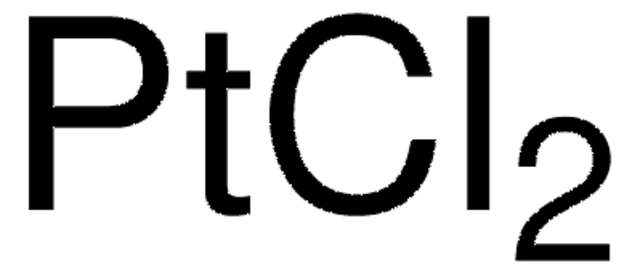Kluczowe dokumenty
520896
Chloroplatinic acid hydrate
≥99.9% trace metals basis
Synonim(y):
Hexachloroplatinic(IV) acid hydrate, Hydrogen hexachloroplatinate(IV) hydrate, Platinic chloride hydrate
About This Item
Polecane produkty
Poziom jakości
Próba
≥99.9% trace metals basis
skład
Pt, 37-40%
mp
60 °C (lit.)
gęstość
2.43 g/mL at 25 °C (lit.)
ciąg SMILES
O.Cl.Cl.Cl[Pt](Cl)(Cl)Cl
InChI
1S/6ClH.H2O.Pt/h6*1H;1H2;/q;;;;;;;+4/p-4
Klucz InChI
SLIOYUPLNYLSSR-UHFFFAOYSA-J
Szukasz podobnych produktów? Odwiedź Przewodnik dotyczący porównywania produktów
Powiązane kategorie
Opis ogólny
Zastosowanie
- in the determination of potassium, by selective precipitation as potassium chloroplatinate.
- in the purification of platinum.
- In catalysis during the addition of silicon hydrides to olefinic double bonds and in platinum-catalyzed hydrosilylation of alkynes.
Przechowywanie i stabilność
2. Recommended for one time use to prevent water absorption and degradation. If necessary, once opened, repack and seal under dry inert gas.
3. Store with care. Prevent from light. Always store in well-sealed containers in a dry inert atmosphere. Recommended to store containers in a secondary desiccator with desiccant in a dry inert atmosphere.
Hasło ostrzegawcze
Danger
Zwroty wskazujące rodzaj zagrożenia
Zwroty wskazujące środki ostrożności
Klasyfikacja zagrożeń
Acute Tox. 3 Oral - Eye Dam. 1 - Resp. Sens. 1 - Skin Corr. 1B - Skin Sens. 1
Kod klasy składowania
6.1C - Combustible acute toxic Cat.3 / toxic compounds or compounds which causing chronic effects
Klasa zagrożenia wodnego (WGK)
WGK 1
Temperatura zapłonu (°F)
Not applicable
Temperatura zapłonu (°C)
Not applicable
Środki ochrony indywidualnej
Eyeshields, Faceshields, Gloves, type P3 (EN 143) respirator cartridges
Wybierz jedną z najnowszych wersji:
Masz już ten produkt?
Dokumenty związane z niedawno zakupionymi produktami zostały zamieszczone w Bibliotece dokumentów.
Klienci oglądali również te produkty
Nasz zespół naukowców ma doświadczenie we wszystkich obszarach badań, w tym w naukach przyrodniczych, materiałoznawstwie, syntezie chemicznej, chromatografii, analityce i wielu innych dziedzinach.
Skontaktuj się z zespołem ds. pomocy technicznej












